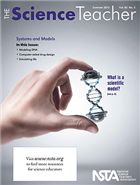Soaring in a Digital Ecosystem
By sstuckey
Posted on 2016-07-21
This column regularly describes digital tools to help teachers make learning more personal and effective for all students. When these tools converge, they create a sort of digital ecosystem designed to make students more collaborative and innovative, skills essential for success in today’s world. But are your students truly using digital technology to its maximum benefit?
The SAMR model
Our efforts toward digital convergence are based on the Substitution  Augmentation Modification Redefinition (SAMR) model (http://bit.ly/1mFgc1l) (see box), which leads to higher-order technology in the classroom. Used at a low level, technology merely serves as a substitution—for example, using a word processor instead of paper and pencil to write a conclusion.
Augmentation Modification Redefinition (SAMR) model (http://bit.ly/1mFgc1l) (see box), which leads to higher-order technology in the classroom. Used at a low level, technology merely serves as a substitution—for example, using a word processor instead of paper and pencil to write a conclusion.
The next level is augmentation, in which technology improves on a learning task similar to what students could do without the technology, such as using the formatting tools in a word processor to highlight areas of interest. Much of classroom technology falls into these two categories, including scientific probes and graphing calculators (www.desmos.com). Our goal is to move on to the next levels of technology use: modification and redefinition of student work to demonstrate understanding.
Getting to Modification and Redefinition
To help you look at your lessons through a SAMR lens, let’s put a sample activity—a traditional chemical reactions experiment—through the SAMR continuum. First, students might use technology to substitute for an analog tool, such as using an online stopwatch (e.g., www.online-stopwatch.com)—instead of an actual stopwatch to time a reaction. To compare the physical and chemical properties of compounds being used in their reactions, students might substitute online reference guides (e.g., www.webelements.com, www.chemicalelements.com) for the paper periodic tables crammed into their backpacks or binders.
The next step up, augmentation, includes tools that give students time to analyze data rather than merely collecting it. Examples include using graphing software (e.g., https://plot.ly/plot, www.onlinecharttool.com and www.chartle.net) and data-collecting probes (such as those found at www.pasco.com and www.vernier.com) to quickly gather data about the chemical reactions so students can focus on describing the reorganization of matter in their products to evidence learning.
Traditionally, we may have asked students to complete a worksheet with data tables and analysis questions, a task that could be substituted by an online Google Doc or Form. But now we can modify this task—advancing to the next level—by asking students to create a podcast (using, for example, http://vocaroo.com) that describes what they saw as the chemical reaction occurred. We could also ask them to video (using, for example, www.wevideo.com or www.magisto.com) what they saw, narrating in voiceover how bonds are breaking and new ones are being formed. With the right device, they could even mark up that video (using, for example, www.coachmyvideo.mobi or www.coachseye.com). Turning in such an assignment could be as simple as sharing a URL or dropping a file into a shared folder (e.g., https://apps.google.com, www.dropbox.com).
But why not completely redefine how student work is assessed and evaluated by asking students to critique each other’s work (https://voicethread.com) and extend the thinking of the student who created it? This type of collaboration and discussion, previously only available in text-based discussion boards, allows students to build and grow their learning network and share their innovative products with peers in a meaningful way.
Conclusion
Digital convergence really means increased engagement and higher-order thinking in our students. Look at the technology available in your own classroom and ask whether students are using it to reach new heights in their learning.
Ben Smith (ben@edtechinnovators.com) is a physics teacher in Red Lion, Pennsylvania; and Jared Mader (jared@edtechinnovators.com) is the director of technology for the Lincoln Intermediate Unit in New Oxford, Pennsylvania. They conduct teacher workshops on technology in the classroom nationwide.
Get Involved With NSTA!
 Join NSTA today and receive The Science Teacher, the peer-reviewed journal just for high school teachers; to write for the journal, see our Author Guidelines and Call for Papers; connect on the high school level science teaching list (members can sign up on the list server); or consider joining your peers at future NSTA conferences.
Join NSTA today and receive The Science Teacher, the peer-reviewed journal just for high school teachers; to write for the journal, see our Author Guidelines and Call for Papers; connect on the high school level science teaching list (members can sign up on the list server); or consider joining your peers at future NSTA conferences.
The mission of NSTA is to promote excellence and innovation in science teaching and learning for all.
Future NSTA Conferences
5th Annual STEM Forum & Expo, hosted by NSTA
- Denver, Colorado: July 27–29
2017 Area Conferences
- Baltimore, Maryland: October 5–7
- Milwaukee, Wisconsin: November 9–11
- New Orleans, Louisiana: November 30–December 2
National Conferences
- Los Angeles, California: March 30–April 2, 2017
- Atlanta, Georgia: March 15–18, 2018
- St. Louis, Missouri: April 11–14, 2019
- Boston, Massachusetts: March 26–29, 2020
- Chicago, Illinois: April 8–11, 2021
Follow NSTA
Disclaimer: The views expressed in this blog post are those of the author(s) and do not necessarily reflect the official position of the National Science Teaching Association (NSTA).


